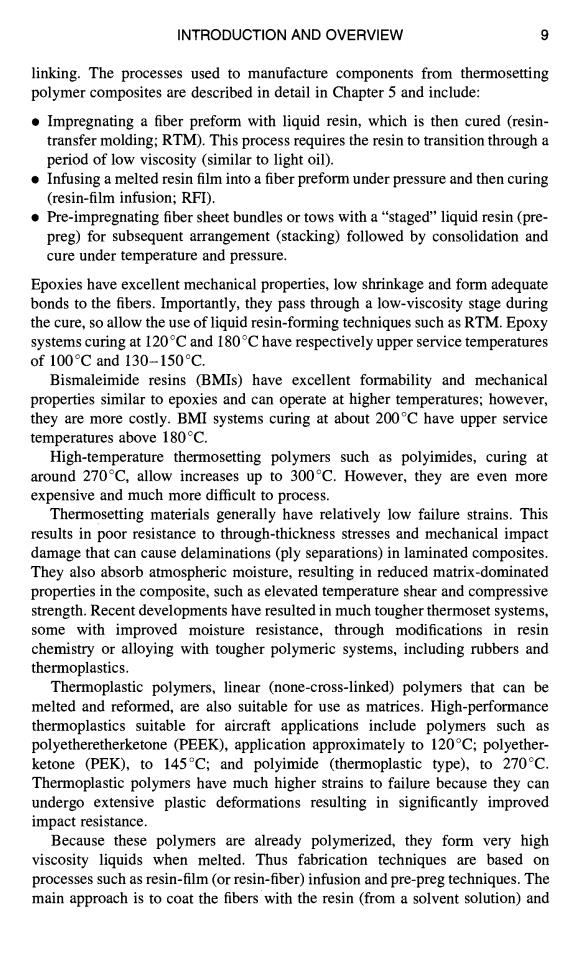正在加载图片...

INTRODUCTION AND OVERVIEW 9 linking.The processes used to manufacture components from thermosetting polymer composites are described in detail in Chapter 5 and include: Impregnating a fiber preform with liquid resin,which is then cured(resin- transfer molding;RTM).This process requires the resin to transition through a period of low viscosity (similar to light oil). Infusing a melted resin film into a fiber preform under pressure and then curing (resin-film infusion;RFI). Pre-impregnating fiber sheet bundles or tows with a"staged"liquid resin(pre- preg)for subsequent arrangement(stacking)followed by consolidation and cure under temperature and pressure. Epoxies have excellent mechanical properties,low shrinkage and form adequate bonds to the fibers.Importantly,they pass through a low-viscosity stage during the cure,so allow the use of liquid resin-forming techniques such as RTM.Epoxy systems curing at 120C and 180Chave respectively upper service temperatures of100°Cand130-150C. Bismaleimide resins (BMIs)have excellent formability and mechanical properties similar to epoxies and can operate at higher temperatures;however, they are more costly.BMI systems curing at about 200C have upper service temperatures above 180C. High-temperature thermosetting polymers such as polyimides,curing at around 270C,allow increases up to 300C.However,they are even more expensive and much more difficult to process. Thermosetting materials generally have relatively low failure strains.This results in poor resistance to through-thickness stresses and mechanical impact damage that can cause delaminations(ply separations)in laminated composites. They also absorb atmospheric moisture,resulting in reduced matrix-dominated properties in the composite,such as elevated temperature shear and compressive strength.Recent developments have resulted in much tougher thermoset systems, some with improved moisture resistance,through modifications in resin chemistry or alloying with tougher polymeric systems,including rubbers and thermoplastics. Thermoplastic polymers,linear (none-cross-linked)polymers that can be melted and reformed,are also suitable for use as matrices.High-performance thermoplastics suitable for aircraft applications include polymers such as polyetheretherketone (PEEK),application approximately to 120C;polyether- ketone (PEK),to 145C;and polyimide (thermoplastic type),to 270C. Thermoplastic polymers have much higher strains to failure because they can undergo extensive plastic deformations resulting in significantly improved impact resistance. Because these polymers are already polymerized,they form very high viscosity liquids when melted.Thus fabrication techniques are based on processes such as resin-film(or resin-fiber)infusion and pre-preg techniques.The main approach is to coat the fibers with the resin (from a solvent solution)andINTRODUCTION AND OVERVIEW 9 linking. The processes used to manufacture components from thermosetting polymer composites are described in detail in Chapter 5 and include: • Impregnating a fiber preform with liquid resin, which is then cured (resintransfer molding; RTM). This process requires the resin to transition through a period of low viscosity (similar to light oil). • Infusing a melted resin film into a fiber preform under pressure and then curing (resin-film infusion; RFI). • Pre-impregnating fiber sheet bundles or tows with a "staged" liquid resin (prepreg) for subsequent arrangement (stacking) followed by consolidation and cure under temperature and pressure. Epoxies have excellent mechanical properties, low shrinkage and form adequate bonds to the fibers. Importantly, they pass through a low-viscosity stage during the cure, so allow the use of liquid resin-forming techniques such as RTM. Epoxy systems curing at 120 °C and 180 °C have respectively upper service temperatures of 100°C and 130-150°C. Bismaleimide resins (BMIs) have excellent formability and mechanical properties similar to epoxies and can operate at higher temperatures; however, they are more costly. BMI systems curing at about 200°C have upper service temperatures above 180 °C. High-temperature thermosetting polymers such as polyimides, curing at around 270°C, allow increases up to 300°C. However, they are even more expensive and much more difficult to process. Thermosetting materials generally have relatively low failure strains. This results in poor resistance to through-thickness stresses and mechanical impact damage that can cause delaminations (ply separations) in laminated composites. They also absorb atmospheric moisture, resulting in reduced matrix-dominated properties in the composite, such as elevated temperature shear and compressive strength. Recent developments have resulted in much tougher thermoset systems, some with improved moisture resistance, through modifications in resin chemistry or alloying with tougher polymeric systems, including rubbers and thermoplastics. Thermoplastic polymers, linear (none-cross-linked) polymers that can be melted and reformed, are also suitable for use as matrices. High-performance thermoplastics suitable for aircraft applications include polymers such as polyetheretherketone (PEEK), application approximately to 120°C; polyetherketone (PEK), to 145°C; and polyimide (thermoplastic type), to 270°C. Thermoplastic polymers have much higher strains to failure because they can undergo extensive plastic deformations resulting in significantly improved impact resistance. Because these polymers are already polymerized, they form very high viscosity liquids when melted. Thus fabrication techniques are based on processes such as resin-film (or resin-fiber) infusion and pre-preg techniques. The main approach is to coat the fibers with the resin (from a solvent solution) and